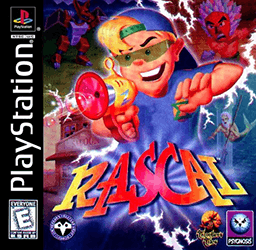Rascal (video game)
| Rascal (video game) | |
|---|---|
 North American cover art | |
| Developer(s) | Traveller's Tales |
| Publisher(s) |
|
| Composer(s) | Andy Blythe & Marten Joustra |
| Platform(s) | PlayStation |
| Release date(s) |
|
| Genre(s) | Platform |
| Mode(s) | Single-player |
| Distribution | CD-ROM |
Rascal, known as Bubblegun Kid (バブルガンキッド) in Japan, is a platform game developed by Traveller's Tales and published by Psygnosis (Takara in Japan) and was released for the PlayStation in Europe on March 1998, in North America on March 31, 1998 and in Japan on March 18, 1999. The main character and several enemies were designed by the Jim Henson's Creature Shop.[1]
Plot
Professor Clockwise is in his lab making the final adjustments to his time travelling device, but a large shadow creeps up behind him. Meanwhile his son Callum "Rascal" Clockwise is walking through a secret route under the house to get to his father's lab when suddenly the lights go out and an alarm sounds. Rascal rushes down to see the problem, but to his horror two aliens in spacecraft appear and chase him down the corridor.
Rascal finally makes it to his father's lab by going through the safe door entrance. He sees Chronon the evil master of time torturing his dad and holding him at gunpoint with another of his dad's inventions called the "Bubble Gun", but the villain accidentally activates the controls for the time machine and he and the Professor are sucked into the portal. The Bubble Gun manages to be released from the portal and lands at Rascal's feet, he picks it up, vowing to save his dad.
After travelling through time and finding Chronon, Rascal successfully defeated him and rescued his dad. After escaping using another time portal, Rascal and his dad were safely back home, however the portal shattered trapping Chronon in interdimensional time forever.
Gameplay
In the game, the player assumes the role of Rascal armed with the Bubble Gun, in a mission through six worlds involving a medieval castle, ancient Aztec ruins, the aquatic city of Atlantis, a Pirate ship and a Western town. You started at Rascal's house and entered each level by going in a certain room and a time portal. In nearly every stage you had to pick up six pieces of an hourglass to open the portal to take you back home and obtain keys to unlock other rooms to other worlds.
Reception
| Reception | ||||||||||||||||||||||||||||||||||||||||||||||||||||||||||||||
|---|---|---|---|---|---|---|---|---|---|---|---|---|---|---|---|---|---|---|---|---|---|---|---|---|---|---|---|---|---|---|---|---|---|---|---|---|---|---|---|---|---|---|---|---|---|---|---|---|---|---|---|---|---|---|---|---|---|---|---|---|---|---|
| ||||||||||||||||||||||||||||||||||||||||||||||||||||||||||||||
The game was very badly received by critics and gamers alike. The main criticisms leveled at the game was a relentlessly problematic camera, and loose controls, forcing the player to predict where they will land when jumping off of an object. 3D platform games were in vogue at the time, following the success of Super Mario 64 , Crash Bandicoot in 1996 (which was marked one of the best games of the year), and Croc: Legend of the Gobbos the previous year. Rascal was perceived by many as a half-hearted attempt to jump on this bandwagon, but it failed to perform as well as expected, although it was praised for its graphics.
References
- ↑ 1.0 1.1 "Rascal - NowGamer". Retrieved 17 February 2013.
- ↑ "Rascal Review". GameSpot. Retrieved March 13, 2013.